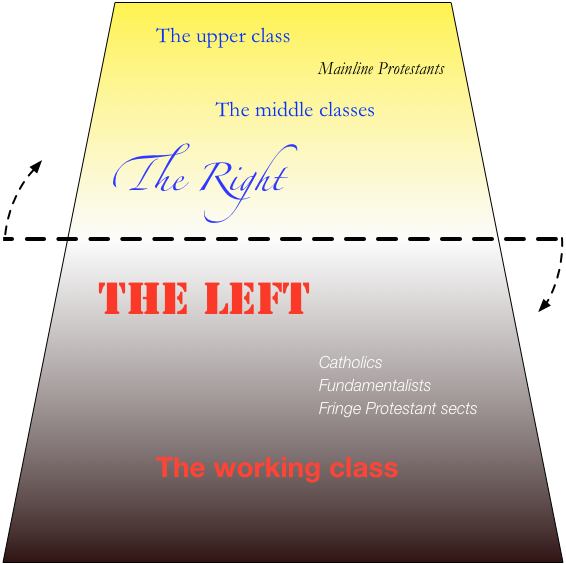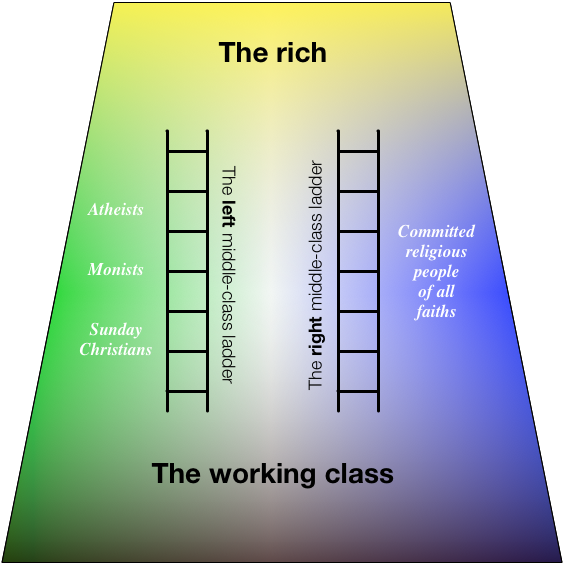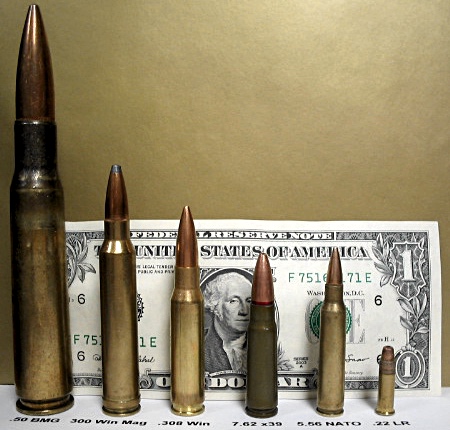
I write this during the 2016 American presidential election campaign, which portends a massive political realignment. The two countercultures of the 1960s-80s created stable party coalitions that persisted for decades. This year, they are breaking up.
Understanding where these coalitions came from may help understand how they have functioned, why American politics is so polarized, and what may happen next.
The countercultures redefined the American “left” and “right” from economic to “values” ideologies. Politics shifted from arguments about pragmatic policy questions to fights over meaningness itself. The Democratic and Republican Parties repositioned themselves as champions of monist and dualist countercultural values, respectively. This polarizes American politics irresolvably.
The countercultures’ political realignment created a new, two-track social class system. It’s personally useful to understand social class better, because it motivates so much of what we all do; but it is also always funny, because we work so hard to hide that from ourselves.
Left and right vary in meaning
In any particular time and place, political affiliation tends to range along a single continuum, which gets labeled left to right. However, “left” and “right” mean quite different things in different places and eras. Ideologues often claim that “what left and right really mean is”—whatever serves their argument. However, political scientists agree that there is no defining issue or axis that consistently distinguishes the two. In American politics, left and right have been redefined several times.
During the countercultural era, the New Left and New Right replaced the Old Left and Old Right. My previous page analyzed the goals of these New movements in cultural terms. Here I look at their implementation in electoral politics.
American first-past-the-post voting rules force a two-party system.1 For many issues, there are more than two possible choices; and groups who agree on one topic may disagree on another. These facts imply that the two parties must always assemble incoherent coalitions of interest groups, somehow held together to cover roughly half the voters. When the sizes of groups change, or a group changes its party affiliation, the system becomes unstable, and new coalitions must be organized.
My account of the countercultural realignment is not a general theory; it is about a specific period in American history. There were partly similar political realignments in some other places around the same time. However, the details of the American rotation were unique, and some key events were just accidental.2 The realignment was driven partly by judicial and legislative actions that granted black Americans voting rights in practice, not just theory. It was also driven partly by economic changes, specifically the growth of the middle class.
So, a “rotation” might have occurred even without the countercultures. However, the parties seized those as powerful, coherent cultural ideologies that could hold together new electoral coalitions.
The Great Rotation
Two diagrams summarize the change. The first illustrates the meanings of “left” and “right” as of 1960:

The main political division was between economic classes.3 The Old Left, and the Democratic Party, represented the working class. The Old Right, and the Republican Party, represented the middle and upper classes. The working class was the majority, and the Democrats had dominated elections for several decades.
Religions aligned with economic class, and with politics.4 The Mainline Protestant denominations were middle class and Republican. Catholics, Fundamentalists, Charismatics, and other “sects” were working class and Democrats. Religious people identified primarily with their denomination, and were hostile to denominations that had significantly different theologies.
During the countercultural era, the main political division “rotated clockwise,” as indicated by the dashed arrows in the diagram above.5 By 1980, “left” and “right” had new meanings:

The new politics of meaning was primarily a division within the middle class, who were now an electoral majority.6 The New Left mainly promoted social freedoms and the social rights of non-economic demographic groups (race, sex, sexual orientation, etc.). It explicitly disclaimed interest in the working-class economic concerns of the Old Left.7 The New Right mainly promoted a “large-family values” agenda, despite its alliance with business groups.
Religion realigned along with politics:
The New Right, invented by Fundamentalists, united highly-observant religious people of all religions, denominations, and sects. The three leaders of the Moral Majority were a Protestant, a Catholic, and a Jew. That was a deliberate statement that all religious conservatives share key moral values, so arcane theological disputes should be put aside.8
The New Left united everyone else: atheists, agnostics, “spiritual but not religious” monists, and Christians who didn’t go to church, or didn’t let God get in the way of a normal life. That last category included a majority of Mainline Protestants.
The new two-track class system
The broad prosperity of the 1960s defused the economic class conflicts that had dominated politics from the beginning of the century. For the middle class, social status became more important than income, because everyone in the class had everything they really needed. Americans’ class was increasingly determined by their cultural values, rather than by income.
Social status came to be largely a matter of mouthing counterculturally-correct opinions. I wrote about this at length in “Ethics is advertising”:
The countercultures split the American middle class into two hostile tribes. Members of both considered anyone in the other tribe inherently immoral. With us, or against us! To be minimally acceptable as a human being, you had to demonstrate commitment to the correct side.
The middle class developed parallel social status ladders. You climb one of the ladders by demonstrating skill in conforming to, and expressing, either monist or dualist values.
To count as a member in good standing of the monist (“left”) tribe, you needed to have the correct opinion about hundreds of issues. You had to like tofu, Bob Dylan, Cesar Chavez, and Tom Robbins, and to hate nuclear power, Dolly Parton, Ronald Reagan, and the Moral Majority.
To be upper middle class, you need to be able to figure out, on the fly, what would be the correct opinion about things that are new to you. This requires conceptual sophistication: years of study not only of details, but also of ways to think. That is what a liberal arts education used to be for.
The great thing about the new system is that everyone in the monist middle class could consider themselves superior to everyone in the dualist one, and vice versa. Morally, at least, and that’s what counts in the new class system. Suddenly, everyone was above average!
Unfortunately, to maintain above-average status, everyone on each ladder has to constantly reinforce their belief in the worthlessness and moral degeneracy of everyone on the other one. This is one reason the culture war is so bitter and intractable. We fear that if it ended, we’d have to go back to measuring our self-worth in dollars, rather than political correctness.
Also unfortunately, making “values” a major determinant of social worth created an endless negative-sum signaling competition for position on each ladder. This game is negative-sum because the main signaling techniques involve conspicuous wastes of time and cognitive effort. Also, of course, the whole culture-war “values” game is negative-sum because it’s actively harmful to social cohesion and sensible government.
One of the best innovations of the subcultural mode was to create a panoply of small status hierarchies, so we could ignore the social status and signaling efforts of everyone outside our subculture. This is much healthier for individuals, but unfortunately it allowed Generation X to drop out of political involvement. That meant the Baby Boomers’ destructive culture war persisted long after the death of their countercultures.
Meanwhile, the culture war was cheerfully coopted by consumer capitalism. Income does still contribute to your position on the middle class ladder, even if it does not determine it. Every conceivable category of consumer product comes in monist and dualist versions, at a full range of price points. You can precisely signal which ladder you are on, and how high up, by what you fill your house with.
I do most of my shopping in Reno, Nevada. Reno has two upscale malls, a monist mall and a dualist mall.9 The monist mall is anchored by an Apple Store; the dualist mall is anchored by Scheels, which sells thousands of guns from a showroom floor the size of half a football field.

At the Apple Store, for $9,827.00 you can get a fully-spec’d Mac Pro with a 12-core Xeon E5 processor, 64GB of DDR3 ECC RAM, and dual D700 FirePro GPUs with 12GB of GDDR5 VRAM. That’s 7 teraflops of crunch, and you’ve got 528 GB/s of memory bandwidth. You can drive eight streams of 4K video in real time. It’s plenty powerful enough to do 3D animation and post-production for major studio films.

That’s insane, nobody needs a computer like that at home. Anyway, Apple doesn’t even make real computers. Just pansy-ass crap for kids and art fags, promoted by the Dalai fucking Lama.
Hey, maybe I’ll make an indie video game hit and make a squillion dollars. Don’t think I couldn’t do it! I’d need a computer like that.

At Scheels, for $12,371.99 you can get a fully-spec’d Barrett 82A1 rifle with an ATACR 5-25x56F1 scope. The semiautomatic 82A1 fires .50 BMG heavy machine gun rounds. It’s accurate at 1800 meters, and .50 BMG will go through brick and concrete walls, or destroy a truck’s engine block. The US military uses it in anti-materiel applications: you can take out an aircraft, in a closed hangar, with a single shot.

The second-largest, the .300 Win Mag, is a standard for big-game hunting and for military and law-enforcement sniper rifles.
That’s insane, there’s no conceivable civilian use for a thing like that. Assault rifles are bad enough, but gun nuts can at least pretend they are going to use them for hunting or “self-defense.” Why do we let these fucking fascist-wannabe rednecks buy military heavy weapons?
Hey, maybe there’s going to be a major terrorist attack, or a civil uprising. Don’t think it couldn’t happen here! I’d need a gun like that.

Counterculturalism, rebellion, and authority
The mainstream power structure resisted replacement, so both countercultures adopted the stance of romantic rebellion. “It’s the system, man!” was the hippie explanation for everything wrong with the world. Or, as the New Left called it, “The Establishment.”
Romantic rebellion is not supposed to succeed—success isn’t romantic, it’s practical. But the mainstream was so rotten that it caved, both times, within a few years, making counterculturalists the new Establishment. That left them with no mainstream to rebel against. They had to resort to rebelling against each other, or to denouncing “The Establishment,” which was now themselves. This was ridiculous, and has made a dysfunctional mess of politics ever since.
The monist counterculture was initially highly anti-authoritarian and anti-Establishment, but as it gained power in the Democratic Party, it had to become less so. Its descendant, the current American left, abandoned anti-authoritarianism long ago, and is comfortable using government power to redress perceived social injustices.
The right was traditionally the party of the established order, even though the Republicans had mostly been out of power since the Great Depression. The right’s opposition to the monist counterculture was initially conceived antidisestablishmentarianistically, as preserving traditional institutions against long-haired drug-fueled barbarians. However, by the mid-1970s, a series of liberal Supreme Court decisions—Roe v. Wade (abortion), Bob Jones University (racial segregation in religious schools), and Engel v. Vitale (prayer in public schools)—plus the expected ratification of the ERA (women’s rights)—made it obvious that the system had been seized by perverts.
The New Right organized as a response to these outrages. Allegiance to the Establishment was no longer tenable. Thenceforth, the Republican Party too positioned itself as a radical insurgency against a corrupt establishment. And as the left became increasingly authoritarian, the right could claim increasingly plausibly to be the party of individual liberties.
Decades later, powerful politicians from both parties campaign “against the government” and denounce “Washington insiders.” Such absurdity has had dire consequences for the quality of governance.
The Forever War, and its end
Shifting political conflict from economic to “values” issues lowered the stakes, but pumped up the rhetorical viciousness. Politics can often find reasonable compromises, or even win-win solutions, to economic contests. The Great Rotation created an endless holy war of dueling eternalisms:
- The countercultures’ “values” are, supposedly, sacred religious principles, on which compromise is unthinkable.
- The justifications for the values of each side are metaphysical, and make no sense outside the monist or dualist worldview, so arguing with the other party never goes anywhere.
- In reality, the “values” are mainly tribal shibboleths and claims to personal identity and self-worth—which also resist compromise.
There is a mainstream theory of American political change that says political party realignments occur roughly every 36 years. This is explained by generational replacement. Some political scientists date the last realignment to 1968 (about when the Rotation started); some to 1980 (when it was complete). If you believe in the magic number 36, and start from 1968, we are long overdue. This could be explained in terms of Generation X mostly sitting politics out. Alternatively, if you start from 1980, we’re right on schedule for a major realignment this year (2016).
In any case, I see a current shift to politics in the atomized mode. In “The new politics of meaning,” I called this “the politics of incoherence.” The atomized mode is native for Millennials, and electoral power is passing now from the Baby Boom generation to the Millennials. (Generation X is too small ever to dominate the electorate.) Later, I will discuss atomized politics, as a cultural phenomenon, in detail. How it will function in a two-party system, I cannot currently guess. It includes what I call an “echo counterculture war”; but atomization’s incoherence suggests this cannot persist after the passing of the Boomers.
I hope Generation X, who will be taking institutional leadership from the Baby Boomers over the next decade, will drop the culture war, and can provide adequate structure to keep atomization’s worst consequences at bay.
- 1.This is called Duverger’s law.
- 2.According to Frank Schaeffer, who was personally responsible for making abortion a major political issue, and who was extensively involved in the creation of the Religious Right, the Evangelical-Republican alliance was an unplanned and mistaken marriage of convenience that only occurred because a couple relatively minor players happened to hook up. Also, the Southern Strategy was brilliant and necessary in retrospect, but it developed more by empirical observation than rational planning, and was opposed by much of the Republican Party.
- 3.Left vs. right did not line up perfectly with economics, of course, and there were major political disagreements other than economic ones. Both parties were somewhat incoherent coalitions of convenience before the rotation, just as after. Also, the political alignments of individuals and of groups were generally less coherent, and less polarized, then than now.
- 4.In fact, both before and after the rotation, religion was the best demographic predictor of American political affiliation, according to polling data.
- 5.The details of how this happened, in terms of shifts in voter demographics and electoral calculations by the Party leadership, are fascinating in a geeky way. I am resisting writing about that here, because it is well-documented mainstream political history. If you are interested, you could start with the Wikipedia articles on the Fifth Party System, which was the pre-rotation alignment; the Southern Strategy, which returned the Republican Party to power by gaining the votes of the white rural working class, formerly the core of the Democratic Party; and the Sixth Party System, which is the post-rotation alignment. I’ve also written in some detail about the formation of the alliance between Evangelicals (previously majority Democrats) and the Republican Party in the mid-’70s. Theorists disagree about exactly when the Fifth System ended and the Sixth began. I think it was gradual, from about 1964, when the Republicans first gained support among white Southerners opposed to black civil rights, to the 1980 election of Ronald Reagan.
- 6.A middle class majority meant economic class couldn’t be the basis for a two-party system, which needs a roughly 50/50 split. Put a different way, the Democratic Party had to make a new ideological appeal to the middle class, because its working-class base could no longer keep it in power. The party chose to back monist values, including women’s and racial minority rights, which had previously been Republican issues. That then allowed the Republican party to draw away working-class and lower-middle-class dualists from the Democrats.
- 7.This was the main point of C. Wright Mill’s Letter to the New Left, one of the movement’s key founding documents.
- 8.Conservative Christianity, post-rotation, became largely non-denominational. Given that its leaders had, since the 1920s, wasted most of their energy on vicious sectarian battles over incomprehensible metaphysical minutiae, this was a startling and welcome development.
- 9.Actually, the dualist mall is in Sparks, which is the real Nevada. It’s just across the Truckee River from Reno. Reno is infested with tax exiles from California, so it’s got weird stuff like sushi.
